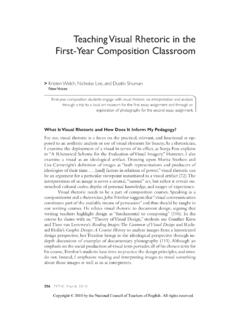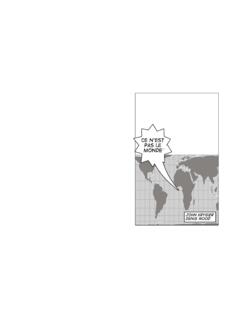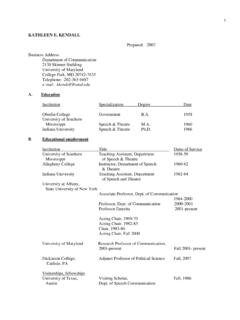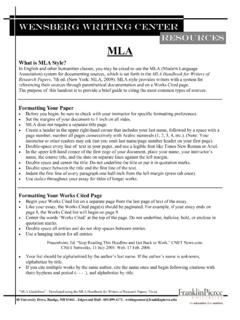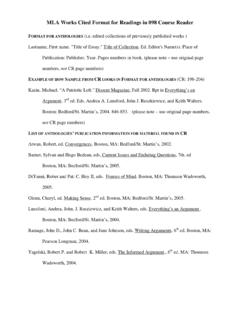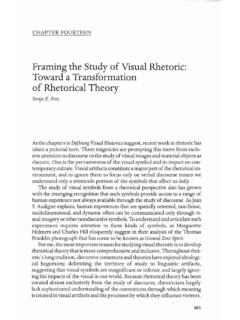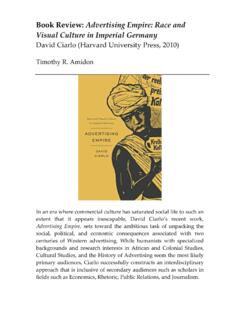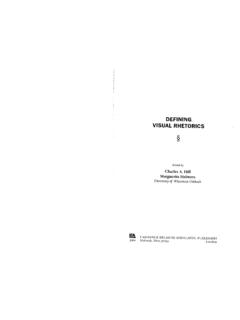Transcription of LIT 6934 Ways of Seeing: Visual Rhetoric/Visual Culture ...
1 LIT 6934. Ways of Seeing: Visual Rhetoric/Visual Culture Sidney I. Dobrin 4414 Turlington Hall M Periods 6-8 (12:50-3:50) Office hours: MW 5 or by Appt. because a way of seeing is also a way of not seeing.. Kenneth Burke Description This course will engage six primary inquires: 1. As we shift from print Culture to screen Culture , how must we rethink the very idea of writing and what it means to write ? 2. Does the idea of rhetoric as we have come to understand it still function in an image- driven information exchange, or what happens when we force image into rhetoric? How do we make a new rhetoric of image? Conterminously, we will also consider how theories of image might inform a Visual rhetoric (or non-rhetoric).
2 3. How do we define a Visual Culture , and what is at stake in claiming that we live in a Visual Culture ? 4. How do we actively participate in Visual Culture as producers and consumers of Visual texts? 5. How do the technologies that are used to produce visuals contribute to/participate in the act of Visual meaning making, particularly when those technologies convert non- Visual information into Visual text ( ultrasound, Doppler, or radio telescope)? 6. How might we address Visual impairment in a Visual Culture ? In order to consider these questions, this course will engage three primary activities: 1. We will read and discuss theories pertaining to Visual rhetorics, Visual cultures, digital literacies, and image theories.
3 2. We will read, analyze and discuss Visual artifacts/texts. 3. We will examine and use new media technologies designed to assist in the invention and production of Visual texts. Required Texts Barry, Ann Marie Seward. Visual Intelligence: Perception, Image, and Manipulation in Visual Communication. Albany, NY: State U of New York P, 1997. ISBN: 0-7914-3436-2.. Note: this is available as ebook form the UF library. Barthes, Roland. Image Music Text. Trans. Stephen Heath. New York: Hill and Wang, 1977. ISBN: 0-374-52136-0. Burnett, Ron. How Images Think. Cambridge, MA: The MIT Press, 2004. ISBN: 0-262-52441-4.. Note: this is available as ebook form the UF library. Hariman, Robert and John Louis Lucaites. No Caption Needed: Iconic Photographs, Public Culture , and Liberal Democracy.
4 Chicago: U of Chicago P, 2007. ISBN: 978-0-226-31606-2. Hill, Charles A. and Marguerite Helmers, eds. Defining Visual Rhetorics. Mahwah, NJ: Lawrence Earlbaum Associates, 2004. ISBN: 978-0-8058-4403-0.. Note: this is available as ebook form the UF library. Mitchell, Picture Theory. Chicago: U of Chicago p, 1994. ISBN: 0-226-53232-1. Smith, Ken, Sandra Moriarty, Gretchen Barbatsis, Keith Kenny, eds. Handbook of Visual Communication: Theory, Methods, and Media. Mahwah, NJ: Lawrence Earlbaum Associates, 2005. ISBN: 0-8058-4179-2.. Note: this is available as ebook form the UF library. *All other readings will be made available by the instructor. Recommended Readings Berger, John. Ways of Seeing. Penguin, 1977. Berger, John.
5 About Looking. Vintage, 1980. Block, Ned, ed. Imagery. Cambridge, The MIT Press, 1981. Chandler, Annmarie and Norie Neumark, eds. At a Distance: Precursors to Art and Activism on the Internet. Cambridge: NIT UP, 2005. Calvino, Italo. The Castle of Crossed Destinies. Harcourt Brace, 1973. Crow, David. Visible Signs. 2nd Edition. AVA Books, 2010. Crow, David. Left to Right: The Cultural Shift from Words to Pictures. AVA Books, 2006. Cubitt, Sean. EcoMedia. New York: Rodopi, 2005. DeLuca, Kevin Michael. Image Politics: The New Rhetoric of Environmental Politics. Mahwah, NJ: Lawrence Earlbaum Associates, 1999. Dobrin, Sidney I. and Sean Morey, eds. Ecosee: Image, Rhetoric, Nature. SUNY P, 2009. Eco, Umberto. The Open Work.
6 Cambridge: Harvard UP, 1989. Elkins, James. The Domain of Images. Ithaca: Cornell up, 1999. Evans, Jessica and Stuart Hall, eds. Visual Culture : The Reader. Sage, 2005. Gibson, James J. The Ecological Approach to Visual Perception. Lawrence Earlbaum Associates, 1986. Gordon, Ian E. Theories of Visual Perception. 3rd ed. New York: Psychology Press, 2004. Gombrich, E. H. Art and Illusion: A Study in the Psychology of Pictorial Representation. Princeton UP, 1960. Hansen, Mark B. N. New Philosophy for New Media. Cambridge: The MIT Press,2004. Hoffman, Donald D. Visual Intelligence: How We Create What We See. New York: Norton, 1998. Lacey, Nick. Image and Representation. Palgrave, 1998. Leeuwen, Theo van and Carey Jewitt.
7 Handbook of Visual Analysis. London: Sage, 2001. Merleau-Ponty, Maurice. The Primacy of Perception and Other Essays. Northwestern UP, 1964. Mirzoeff, Nicholas. An Introduction to Visual Culture . New York: Routledge, 1999. Mitchell, W. J. T. Iconology: Image, Text, Ideology. U of Chicago P, 1986. Mitchell, W. J. T. What do Pictures Want? The lives and Loves of Images. U of Chicago P, 2006. Rose, Gillian. Visual Methodologies. London: Sage, 2001. Shlain, Leonard. The Alphabet versus The Goddess: The Conflict between Word and Image. Penguin, 1998. Sontag, Susan. On Photography. New York: Picador, 1973. Sturken Marita and Lisa Cartwright. Practices of Looking: An Introduction to Visual Culture . Oxford UP, 2002. Virilio, Paul.
8 War and Cinema: The Logistics of Perception. New York: Verso, 1984. Assignments and Requirements The Listserve You may post to the course listserve at The course listserve is intended to serve a twofold purpose: first, it provides a space for continuing or extending conversations we have in class or addressing class readings in ways we were not able to cover in the class. Second, and perhaps more important to the objectives of the seminar, the listserve should be used as a point for sharing stuff we want each other to look at. That is, we should each be posting links to videos, images, articles, and other stuff we want to share with the class, but just don't have time to view during class periods. Please note, you can use the listserve to post links to anything you think is worth seeing or reading, but keep in mind that posting for the sake of flaming will not be tolerated.
9 Therefore, with every link you post to the listserve, you are required to include in the post a short explanation as to why you think we should see what you're showing us. In most instances, the explanation should be relevant to the class; however, showing us something cool for the sake of showing something cool is perfectly legitimate. You can provide links to potentially inappropriate material, so long as you provide an explanation warning us of its inappropriateness and an explanation as to why you're showing us. This gives us each the opportunity to decide whether we want to view it or not. Please keep in mind that posting inappropriate material (yes, I. realize this is a fine line we will be discussing in class) may result in penalty and that posting some visuals might be considered a violation of the University's harassment policies.
10 Think before you post. Throughout the semester, you are required to post (re-posts don't count) ten links. The Wiki For this seminar, you will contribute to an ongoing wiki project designed to develop a bibliography of resources for studying Visual rhetoric, Visual Culture , and Visual literacy. You will find the wiki at You may add or comment on previously added inclusions; however, over the course of the semester, you are required to post at least ten bibliographic citations to the wiki bibliography. Each bibliographic citation should be followed with a short annotation, describing the content and assessing the usefulness of the text. The Blog Each student will create a blog site using any blog service desired ( etc).

